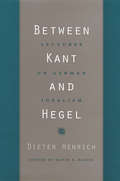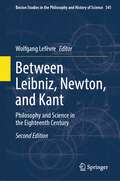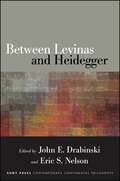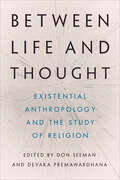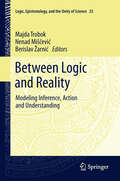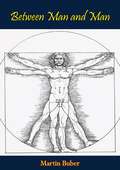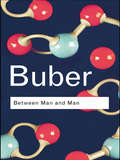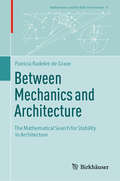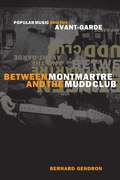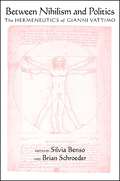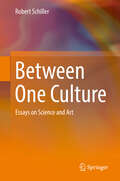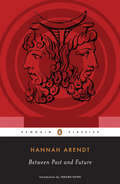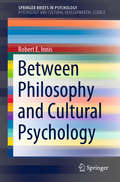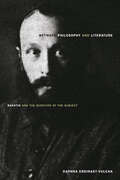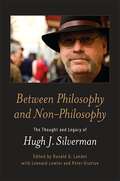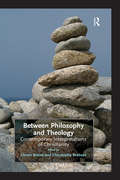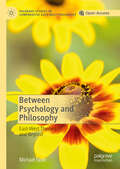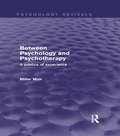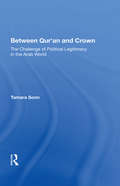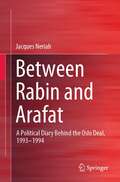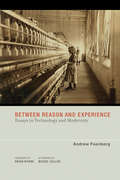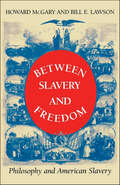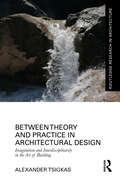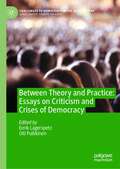- Table View
- List View
Between Kant and Hegel: Lectures on German Idealism
by Dieter HenrichElectrifying when first delivered in 1973, legendary in the years since, Dieter Henrich's lectures on German Idealism were the first contact a major German philosopher had made with an American audience since the onset of World War II. They remain one of the most eloquent explanations and interpretations of classical German philosophy and of the way it relates to the concerns of contemporary philosophy. Thanks to the editorial work of David Pacini, the lectures appear here with annotations linking them to editions of the masterworks of German philosophy as they are now available. Henrich describes the movement that led from Kant to Hegel, beginning with an interpretation of the structure and tensions of Kant's system. He locates the Kantian movement and revival of Spinoza, as sketched by F. H. Jacobi, in the intellectual conditions of the time and in the philosophical motivations of modern thought. Providing extensive analysis of the various versions of Fichte's Science of Knowledge, Henrich brings into view a constellation of problems that illuminate the accomplishments of the founders of Romanticism, Novalis and Friedrich Schlegel, and of the poet Hölderlin's original philosophy. He concludes with an interpretation of the basic design of Hegel's system.
Between Leibniz, Newton, and Kant: Philosophy and Science in the Eighteenth Century (Boston Studies in the Philosophy and History of Science #341)
by Wolfgang LefèvreThis addresses the transformations of metaphysics as a discipline, the emergence of analytical mechanics, the diverging avenues of 18th-century Newtonianism, the body-mind problem, and philosophical principles of classification in the life sciences. An appendix contains a critical edition and first translation into English of Newton's scholia from David Gregory's Estate on the Propositions IV through IX Book III of his Principia.
Between Levinas and Heidegger (SUNY series in Contemporary Continental Philosophy)
by John E. Drabinski; Eric S. NelsonAlthough both Levinas and Heidegger drew inspiration from Edmund Husserl's phenomenological method and helped pave the way toward the post-structuralist movement of the late twentieth century, very little scholarly attention has been paid to the relation of these two thinkers. There are plenty of simple—and accurate—oppositions and juxtapositions: French and German, ethics and ontology, and so on. But there is also a critical intersection between Levinas and Heidegger on some of the most fundamental philosophical questions: What does it mean to be, to think, and to act in late modern life and culture? How do our conceptions of subjectivity, time, and history both reflect the condition of this historical moment and open up possibilities for critique, resistance, and transformation? The contributors to this volume take up these questions by engaging the ideas of Levinas and Heidegger relating to issues of power, violence, secularization, history, language, time, death, sacrifice, responsibility, memory, and the boundary between the human and humanism.
Between Life and Thought: Existential Anthropology and the Study of Religion
by Devaka Premawardhana Don SeemanExistential anthropology is an approach inspired by existential and phenomenological thought to further our understanding of the human condition. Its ethnographic methodology emphasizes embodied experience and focuses on what is at stake for people amid the contingencies, struggles, and uncertainties of everyday life. While anthropological research on religion abounds, there has been little systematic attention to the ways anthropology and religious studies might benefit from better consideration of one another or from the adoption of a shared existential perspective. Between Life and Thought gathers leading anthropologists and religion scholars, including some of existential anthropology’s most recognized advocates and thoughtful critics. The collection opens with a comprehensive introduction to phenomenology and existentialism in anthropology and religious studies and concludes with an analysis of how existential anthropology might address the long-standing problem of constructivism and perennialism in religious studies. The chapters altogether present existential anthropology as an especially generative paradigm with which to rethink and remake both anthropology and the academic study of religion. A timely and significant intervention across multiple areas of research, Between Life and Thought is an invaluable source for critically exploring the prospects, as well as the limits, of an anthropological approach to religion grounded in experiential ethnography and existential thought.
Between Logic and Reality: Modeling Inference, Action and Understanding (Logic, Epistemology, and the Unity of Science #25)
by Berislav Žarnić Nenad Miščević Majda TrobokIs reality logical and is logic real? What is the origin of logical intuitions? What is the role of logical structures in the operations of an intelligent mind and in communication? Is the function of logical structure regulative or constitutive or both in concept formation? This volume provides analyses of the logic-reality relationship from different approaches and perspectives. The point of convergence lies in the exploration of the connections between reality - social, natural or ideal - and logical structures employed in describing or discovering it. Moreover, the book connects logical theory with more concrete issues of rationality, normativity and understanding, thus pointing to a wide range of potential applications. The papers collected in this volume address cutting-edge topics in contemporary discussions amongst specialists. Some essays focus on the role of indispensability considerations in the justification of logical competence, and the wide range of challenges within the philosophy of mathematics. Others present advances in dynamic logical analysis such as extension of game semantics to non-logical part of vocabulary and development of models of contractive speech act.
Between Man and Man (Routledge Classics Ser.)
by Martin BuberIn 1923 a small book was published which was to have enormous impact on more than one generation of theologians and philosophers of religion, Christian and Jew alike, as well as on countless laymen. The book was entitled I and Thou; the author was Martin Buber. Its main point was that all real life is encounter or meeting, to which a man must bring his whole being, his genuine self. This concern with dialogue has marked all Buber’s subsequent works. Between Man and Man takes this dialogical principle and in five related essays applies it to critical problems of modern life, such as politics and education.MARTIN BUBER was born in Vienna in 1878. Educated at the universities of Vienna, Berlin, Leipzig, and Zurich, he became editor of the Vienna Welt, a Zionist periodical. In 1916 he founded Der Jude, which rapidly became the principal voice of German-speaking Jewry and which he edited until 1924. He taught at the University of Frankfurt and directed the educational activities of the Jewish community there during the Nazi rise to power. In 1938 Buber left Germany for Jerusalem, where he was named professor of social philosophy at the Hebrew University. His works include books on Hasidism and Zionism as well as philosophy.
Between Man and Man (Routledge Classics)
by Martin BuberScholar, theologian and philosopher, Martin Buber is one of the twentieth century's most influential thinkers. He believed that the deepest reality of human life lies in the relationship between one being and another. Between Man and Man is the classic work where he puts this belief into practice, applying it to the concrete problems of contemporary society. Here he tackles subjects as varied as religious ethics, social philosophy, marriage, education, psychology and art. Including some of his most famous writings, such as the masterful What is Man?, this enlightening work challenges each reader to reassess their encounter with the world that surrounds them.
Between Mechanics and Architecture: The Mathematical Search for Stability in Architecture (Mathematics and the Built Environment #8)
by Patricia Radelet-de GraveThis collection of essays reflects the author's decades-long dedication to studying the interplay between mechanics and architecture. It explores how advancements in mechanics have influenced architectural innovation and how the need for new architectural solutions has driven theoretical progress in engineering. By examining the historical roots of these fields, these essays provide a deep analysis of key developments. This interdisciplinary work will appeal to scholars, students, and anyone interested in the complex relationship between the theoretical and practical aspects of architecture and civil engineering.
Between Montmartre and the Mudd Club: Popular Music and the Avant-Garde
by Bernard GendronDuring the late nineteenth and early twentieth century, popular music was considered nothing but vulgar entertainment. Today, jazz and rock music are seen as forms of art, and their practitioners are regularly accorded a status on par with the cultural and political elite. To take just one recent example, Bono, lead singer and lyricist of the rock band U2, got equal and sometimes higher billing than Pope John Paul II on their shared efforts in the Jubilee 2000 debt-relief project. When and how did popular music earn so much cultural capital? To find out, Bernard Gendron investigates five key historical moments when popular music and avant-garde art transgressed the rigid boundaries separating high and low culture to form friendly alliances. He begins at the end of the nineteenth century in Paris's Montmartre district, where cabarets showcased popular music alongside poetry readings in spaces decorated with modernist art works. Two decades later, Parisian poets and musicians "slumming" in jazz clubs assimilated jazz's aesthetics in their performances and compositions. In the bebop revolution in mid-1940s America, jazz returned the compliment by absorbing modernist devices and postures, in effect transforming itself into an avant-garde art form. Mid-1960s rock music, under the leadership of the Beatles, went from being reviled as vulgar music to being acclaimed as a cutting-edge art form. Finally, Gendron takes us to the Mudd Club in the late 1970s, where New York punk and new wave rockers were setting the aesthetic agenda for a new generation of artists. Between Montmartre and the Mudd Club should be on the shelves of anyone interested in the intersections between high and low culture, art and music, or history and aesthetics.
Between Montmartre and the Mudd Club: Popular Music and the Avant-Garde
by Bernard GendronDuring the late nineteenth and early twentieth century, popular music was considered nothing but vulgar entertainment. Today, jazz and rock music are seen as forms of art, and their practitioners are regularly accorded a status on par with the cultural and political elite. To take just one recent example, Bono, lead singer and lyricist of the rock band U2, got equal and sometimes higher billing than Pope John Paul II on their shared efforts in the Jubilee 2000 debt-relief project. When and how did popular music earn so much cultural capital? To find out, Bernard Gendron investigates five key historical moments when popular music and avant-garde art transgressed the rigid boundaries separating high and low culture to form friendly alliances. He begins at the end of the nineteenth century in Paris's Montmartre district, where cabarets showcased popular music alongside poetry readings in spaces decorated with modernist art works. Two decades later, Parisian poets and musicians "slumming" in jazz clubs assimilated jazz's aesthetics in their performances and compositions. In the bebop revolution in mid-1940s America, jazz returned the compliment by absorbing modernist devices and postures, in effect transforming itself into an avant-garde art form. Mid-1960s rock music, under the leadership of the Beatles, went from being reviled as vulgar music to being acclaimed as a cutting-edge art form. Finally, Gendron takes us to the Mudd Club in the late 1970s, where New York punk and new wave rockers were setting the aesthetic agenda for a new generation of artists.Between Montmartre and the Mudd Club should be on the shelves of anyone interested in the intersections between high and low culture, art and music, or history and aesthetics.
Between Nihilism and Politics: The Hermeneutics of Gianni Vattimo (SUNY series in Contemporary Italian Philosophy)
by Brian Schroeder Silvia BensoThis is the first collection of essays in English that deals directly with the philosophy of Gianni Vattimo from a purely critical perspective, further establishing his rightful place in contemporary European philosophy. Vattimo, who first came to prominence as the translator of Gadamer's Truth and Method into Italian, is now considered to be more than a philosopher and prolific author. As a former member of the European Parliament (1999–2004), he is also a public intellectual. This book takes up his call to advance the crucial active and affirmative engagement with thinking and society. More than just interpretations of Vattimo's thinking, these essays are expressions of the new impetus given to hermeneutic philosophy by "weak thought," the term he coined for how we think now in the wake of Nietzsche, Heidegger, and Gadamer. The development of Vattimo's thinking is reflected in the organization of the volume, divided into three main parts: Hermeneutics and Nihilism, Metaphysics and Religion, and Politics and Technology.
Between One Culture: Essays on Science and Art
by Robert SchillerThis book argues that science and the arts are not two different cultures, but rather different manifestations of the same culture. Divided into seven parts, it presents a collection of translated and revised essays, mostly at the intersection between realia and humaniora. In the first two parts, the author discusses how some myths, both ancient and modern, have become intertwined with scientific ideas. The chapters in the following four parts address poems, novels, plays, and pieces of fine art that have some scientific content, as well as scientific findings which seem to have also been discovered in art. The chapters in the final part examine a number of inspiring doubts and necessary errors in the history of science. This collection of essays, most of which were originally published in Hungarian, is intended for the general public and as such includes no mathematical, physical or chemical formulae. It offers a unique resource for all those curious about the interconnections between science, art and literature.
Between Past and Future: Eight Exercises in Political Thought (Historia, Ciencia, Sociedad Ser. #Vol. 250)
by Hannah Arendt Jerome KohnArendt's penetrating observations of the modern world, based on a profound knowledge of the past, constitute a major contribution to political philosophy. In this book she describes the perplexing crises which modern society faces as a result of the loss of meaning of the traditional key words of politics: justice, reason, responsibility, virtue, and glory. Copyright © Libri GmbH. All rights reserved.
Between Philosophy and Cultural Psychology (SpringerBriefs in Psychology)
by Robert E. InnisThis Brief provides an in-depth discussion of five major points of intersection between philosophy and cultural psychology. The first chapter frames central analytical and normative threads, foregrounding the focal notion of thresholds of sense. The second chapter explores the nature of contexts, situations, and backgrounds of meaning-making following the lead of John Dewey, Ben-Ami Scharfstein, and Gernot Böhme. Chapter three examines the complementary analytical power of the semiotic resources developed in the work of Peirce, Bühler, and Cassirer. Chapter four shows the heuristic fertility and psychological bearing of Susanne Langer's feeling-based aesthetic model of minding. The final chapter establishes affectivation as the inescapable consequence of human beings giving life to themselves by giving life to signs. The Brief concludes with three commentaries from leading researchers in the area. The chapters weave together interlocking themes: the nature of embodied perception, the variety of contexts and semiotic frameworks and their schematization of thresholds of meaning-making, the role of art and theories of imagination both in cultural psychology and in philosophy, and the centrality of feeling in all forms of meaning-making. Between Philosophy and Cultural Psychology will be of interest to cognitive and cultural psychologists as well as researchers and upper-graduate students in philosophy and related psychology fields.
Between Philosophy and Literature: Bakhtin and the Question of the Subject
by Daphna Erdinast-VulcanThis is an original reading of Mikhail Bakhtin in the context of Western philosophical traditions and counter-traditions. The book portrays Bakhtin as a Modernist thinker torn between an ideological secularity and a profound religious sensibility, invariably concerned with questions of ethics and impelled to turn from philosophy to literature as another way of knowing. Most major studies of Bakhtin highlight the fragmented and apparently discontinuous nature of his work. Erdinast-Vulcan emphasizes, instead, the underlying coherence of the Bakhtinian project, reading its inherent ambivalences as an intersection of philosophical, literary, and psychological insights into the dynamics of embodied subjectivity. Bakhtins turn to literature and poetry, as well as the dissatisfactions that motivated it, align him with three other "exilic" Continental philosophers who were his contemporaries: Bergson, Merleau-Ponty, and Levinas. Adopting Bakhtins own open-ended approach to the human sciences, the book stages a series of philosophical encounters between these thinkers, highlighting their respective itineraries and impasses, and generating a Bakhtinian synergy of ideas.
Between Philosophy and Non-Philosophy: The Thought and Legacy of Hugh J. Silverman
by Donald A. Landes; Leonard Lawlor; Peter GrattonHugh J. Silverman was an inspiring scholar and teacher, known for his work engaging and shaping phenomenology, hermeneutics, psychoanalysis, structuralism, poststructuralism, and deconstruction. As Professor of Philosophy and Comparative Literary and Cultural Studies at Stony Brook University, State University of New York, Silverman's work was marked by "the between," a concept he developed to think the postmodern in the space between philosophy and non-philosophy. In this volume, leading scholars explore and extend Silverman's philosophical contributions, from reflections on the notions of care, time, and responsibility, to presentations of the practices and possibilities of deconstruction itself. They provide an assessment of Silverman's life and work at the intersection of philosophy, ethics, and politics.
Between Philosophy and Theology: Contemporary Interpretations of Christianity
by Christophe BrabantLong past the time when philosophers from different perspectives had joined the funeral procession that declared the death of God, a renewed interest has arisen in regard to the questions of God and religion in philosophy. The turn to secularization has produced its own opposing force. Although they declared themselves from the start as not being religious, thinkers such as Derrida, Vattimo, Zizek, and Badiou have nonetheless maintained an interest in religion. This book brings some of these philosophical views together to present an overview of the philosophical scene in its dealings with religion, but also to move beyond the outsider's perspective. Reflecting on these philosophical interpretations from a fundamental theological perspective, the authors discover in what way these interpretations can challenge an understanding of today's faith. Bringing together thinkers with an established reputation - Kearney, Caputo, Ward, Desmond, Hart, Armour - along with young scholars, this book challenges a range of perspectives by putting them in a new context.
Between Psychology and Philosophy: East-West Themes and Beyond (Palgrave Studies in Comparative East-West Philosophy)
by Michael SloteThis open access book discusses a variety of important but unprecedented ways in which psychology can be useful to philosophy. The early chapters illustrate this theme via comparisons between Chinese and Western philosophy. It is argued that the Chinese notion of a heart-mind is superior to the Western concept of mind, but then, more even-handedly, the relative strengths and weaknesses of Chinese and Western thought overall are critically examined. In later chapters, the philosophical uses of psychology are treated more specifically in relation to major issues in Western philosophy. Michael Slote shows that empathy and emotion play a role in speech acts (like assertion and thanking) that speech act theory has totally ignored. Similarly, he treats the age-old question of whether justice pays using psychological material that has not previously been recognized. Finally, the implications of psychological egoism are discussed in terms of some new psychological and, indeed, human distinctions. Human life is pervaded by instincts and aspirations that are neither egoistic nor altruistic, and recognizing that fact can help put egoism in its place. It is less of a challenge to morality than we have realized.
Between Psychology and Psychotherapy: A Poetics of Experience (Psychology Revivals)
by Miller MairIn this highly original and thought-provoking work the late Miller Mair puts forward his ideas for a new psychology. First published in 1989, he deals with issues of fundamental importance to the future of a psychology guided by genuine enquiry and concern rather than mere professional self-interest. Crossing and re-crossing boundaries between psychology, psychotherapy and philosophy, and between ‘science’ and ‘art’, he demonstrates the linkages between the personal and the impersonal, subject and object, inside and outside, with a daring not previously risked by anyone working in the area. Dr Mair stresses the importance of a poetic approach in psychology and psychotherapy, and the need to explore and understand the nature of psychology through an imaginative freedom of language. He emphasizes that a poetic awareness and attentiveness is fundamental to any pursuit of understanding of ourselves or others. This is a very personal book, concerned with personal knowledge, but it is meant for anyone who seeks to understand themselves and others, and what is involved in coming to such understanding. Focusing on ordinary human experience, and moving towards literary and artistic modes of expression, the author invites you to enter in, follow what you think and feel, as he proposes a radical revision of much that is accepted in psychology and in psychotherapy.
Between Qur'an And Crown: The Challenge Of Political Legitimacy In The Arab World
by Tamara SonnThe struggle for political legitimacy in many Middle Eastern countries today poses a dilemma for ruling elites. In order to maintain authority, leaders often must capitulate to Islamic universalist dogma, which may conflict with their own views of the state as well as threaten the legitimacy of other leaders in the region who are attempting to establish a secular, national basis for government. Tracing the roots of this dilemma in Middle Eastern history and Islamic philosophy, Dr. Sonn compares the contemporary Middle Eastern period to Europe’s “Age of Religious Wars†that preceded the emergence of the Western secular state. She describes how a process similar to the organic development of the secular state in Europe was interrupted in the Middle East by oppressive Western colonialism, which eventually led to the Muslim rejection of nationalism and all things “Western†and to the reassertion of Islam as the sole source of political legitimacy. The author shows how the philosophy of Islamic traditionalism opposes the two fundamentals of stable national political systems—a geographical limitation of authority and an institutionalized process for regular changes in leadership. Dr. Sonn bases her argument on an insightful examination of Middle Eastern history, from the formation and disintegration of the Ottoman Empire in the late nineteenth century to the present, and caps it with a detailed look at a possible solution to the dilemma: the teachings of modern scholars who advocate a new “Islamic realism†incorporating a limited definition of national identity and interests while retaining Islamic social goals.
Between Rabin and Arafat: A Political Diary Behind the Oslo Deal, 1993–1994
by Jacques NeriahThis book shares first-hand insights into the implementation of the Oslo Accords between Israel and the Palestinians, written by a high-ranking Israeli military intelligence officer and former foreign policy advisor to Israel’s fifth prime minister, Yitzhak Rabin. It offers a diary of the political events surrounding the Israeli prime minister in 1993–1994, focusing on a key turning point in the Israeli-Arab conflict – those crucial days when Rabin had to choose between promoting a peace process with the Palestinians or trying to strike a deal with the Syrians and waiting for the Jordanians to join. The book sheds new light on Rabin’s attitudes towards the Palestinians, on his meetings with Yasser Arafat, and on what went on behind the scenes of the official diplomatic negotiations. Readers will learn about the power struggles and ego-driven rivalries between Israeli politicians and high-ranking generals, about the relationship between politicians and the media, and about problems such as the leaking of sensitive information to the press. This book will be of interest not only to scholars, but also and more importantly to policymakers around the world, and to anyone interested in the Israeli-Palestinian conflict and finding a two-state solution in the region.“A vital and extremely well-written book, not only for the academia, but above all for the decision makers across the globe, West and East, North and South, in fact anyone who talks about a two-state solution in the region". Arno Tausch, Professor of Political Science, Innsbruck University, Austria
Between Reason and Experience: Essays in Technology and Modernity (Inside Technology)
by Andrew FeenbergA leading philosopher of technology calls for the democratic coordination of technical rationality with everyday experience.The technologies, markets, and administrations of today's knowledge society are in crisis. We face recurring disasters in every domain: climate change, energy shortages, economic meltdown. The system is broken, despite everything the technocrats claim to know about science, technology, and economics. These problems are exacerbated by the fact that today powerful technologies have unforeseen effects that disrupt everyday life; the new masters of technology are not restrained by the lessons of experience, and accelerate change to the point where society is in constant turmoil. In Between Reason and Experience, leading philosopher of technology Andrew Feenberg makes a case for the interdependence of reason—scientific knowledge, technical rationality—and experience. Feenberg examines different aspects of the tangled relationship between technology and society from the perspective of critical theory of technology, an approach he has pioneered over the past twenty years. Feenberg points to two examples of democratic interventions into technology: the Internet (in which user initiative has influenced design) and the environmental movement (in which science coordinates with protest and policy). He examines methodological applications of critical theory of technology to the case of the French Minitel computing network and to the relationship between national culture and technology in Japan. Finally, Feenberg considers the philosophies of technology of Heidegger, Habermas, Latour, and Marcuse. The gradual extension of democracy into the technical sphere, Feenberg argues, is one of the great political transformations of our time.
Between Slavery and Freedom: Philosophy and American Slavery (Blacks in the Diaspora)
by Bill E. Lawson Howard McGaryUsing the writings of slaves and former slaves, as well as commentaries on slavery, Between Slavery and Freedom explores the American slave experience to gain a better understanding of six moral and political concepts—oppression, paternalism, resistance, political obligation, citizenship, and forgiveness. The authors use analytical philosophy as well as other disciplines to gain insight into the thinking of a group of people prevented from participating in the social/political discourse of their times.Between Slavery and Freedom rejects the notion that philosophers need not consider individual experience because philosophy is "impartial" and "universal." A philosopher should also take account of matters that are essentially perspectival, such as the slave experience. McGary and Lawson demonstrate the contribution of all human experience, including slave experiences, to the quest for human knowledge and understanding.
Between Theory and Practice in Architectural Design: Imagination and Interdisciplinarity in the Art of Building (Routledge Research in Architecture)
by Alexander TsigkasBetween Theory and Practice in Architectural Design: Imagination and Interdisciplinarity in the Art of Building examines the intersection of philosophy and practice in architecture, exploring life, viability, and interdisciplinary collaboration and offering practical design insights for all beings.This book highlights several key architectural features, including a philosophical exploration of life, a focus on creating organic spaces, and the use of the viable system model (VSM) for organisational resilience. Additionally, it emphasises interdisciplinary design thinking and introduces a platform for viable and agile AI-assisted design. The book provides practical case studies highlighting how theory and practice can be integrated into architectural projects, giving architects actionable insights for innovative, adaptive, and purposeful design. By utilising organic design principles and interdisciplinary collaboration, readers will gain a transformative understanding of architecture. The book encourages the application of the viable system model to enhance organisational viability while promoting flexibility and viability in design. Furthermore, architects are encouraged to use logic-based and object-oriented ontology (OOO)-based AI-assisted design approaches due to their ability to evaluate design scenarios quickly.This book will be of interest to architects, designers, and enthusiasts seeking a comprehensive understanding of architecture, and professionals in architectural enterprises looking to enhance organisational viability will find value. Interdisciplinary collaboration is emphasised throughout the book. Students and academics in architecture and related fields will also benefit from its philosophical exploration and practical insights.
Between Theory and Practice: Essays on Criticism and Crises of Democracy (Challenges to Democracy in the 21st Century)
by Eerik Lagerspetz Oili PulkkinenIs it possible, in the complex modern world, to have a government ‘by the people’? Does, for example, digital technology help us to bring the reality closer to the ideal? Or does it actually make the ideal unattainable?The volume brings together conceptual historians, philosophers, political theorists and sociologists to discuss the criticisms and crises of democracy with fresh approaches to the idea of democracy, democratic theory, democratic institutions, trust and distrust, populism, and advancement of technologies in Western societies.
